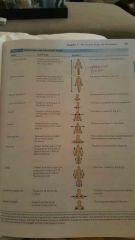![]()
![]()
![]()
Use LEFT and RIGHT arrow keys to navigate between flashcards;
Use UP and DOWN arrow keys to flip the card;
H to show hint;
A reads text to speech;
9 Cards in this Set
- Front
- Back
- 3rd side (hint)
|
Explain the principle of complementarity |
That you can study anatomy without physiology but they really are inseparable because function always reflects structure. |
|
|
|
In increasing order of complexity name the different levels of structural organization that make up the human body |
Atoms --> molecules --> cells --> tissues --> organs --> organ systems --> organisms (i.e. humans ) |
|
|
|
List the 11 organ systems of the body and briefly explain the major function of each system |
1. Cardiovascular/circulatory = transports nutrients & wastes, hormones &gases 2. Digestive = extracts and absorbs nutrients from food, removes wastes and maintains water &chemical balances 3. Endocrine = regulates body temperature, metabolism, development, reproduction, and maintains homeostasis 4. Excretory = removes wastes from blood, regulates concentrations of body fluids 5. Lymphatic/Immune = defends against pathogens 6. Integumentary = protects against injury, infection, and fluid loss. Helps regulate body temperature 7. Muscular = moves limbs and trunk, moves substances thru body, provides structure and support 8. Nervous = regulates behavior, maintains homeostasis, controls sensory and motor functions 9. Reproductive = produces gamete and offspring 10. Respiratory = moves air in and out of lungs, controls gas exchange between blood and lungs 11. Skeletal = protects and supports the body and organs |
|
|
|
Compare and contrast negative and positive feedback and describe the role of each in maintaining body homeostasis |
In negative feedback the output shuts off the original stimulus or reduces it's intensity. Most homeostatic control mechanisms. I.e. regulation of body temperature and control of blood volume.
In positive feedback the response enhances the original stimulus so that the activity(output) is accelerated. Aka waterfall effect. I.e. blood clotting and labor contractions |
|
|
|
Appraise the relationship between homeostatic imbalance and disease |
Homeostatic imbalance is a disturbance in homeostasis. Homeostasis is so important most diseases can be regarded as a result of its disturbance. |
|
|
|
Define anatomical terminology including anatomy, physiology, the anatomical position. |
Anatomy= the study of body structures Physiology= the study of the functions of living organisms Anatomical position= the body is erect with feet slightly apart with palms facing forward and thumbs point away from the body.
|

|
|
|
Name the nine regions and four quadrants of the abdominopelvic cavity and list the organs they contain |
1. Region |
|
|
|
Describe the structure of the cell and explain how it relates to function |
The cell is made up of |
|
|
|
Compare and contrast positive and negative feedback and describe the role of each in maintaing body homeostasis |
Negative feedback is when |
|

